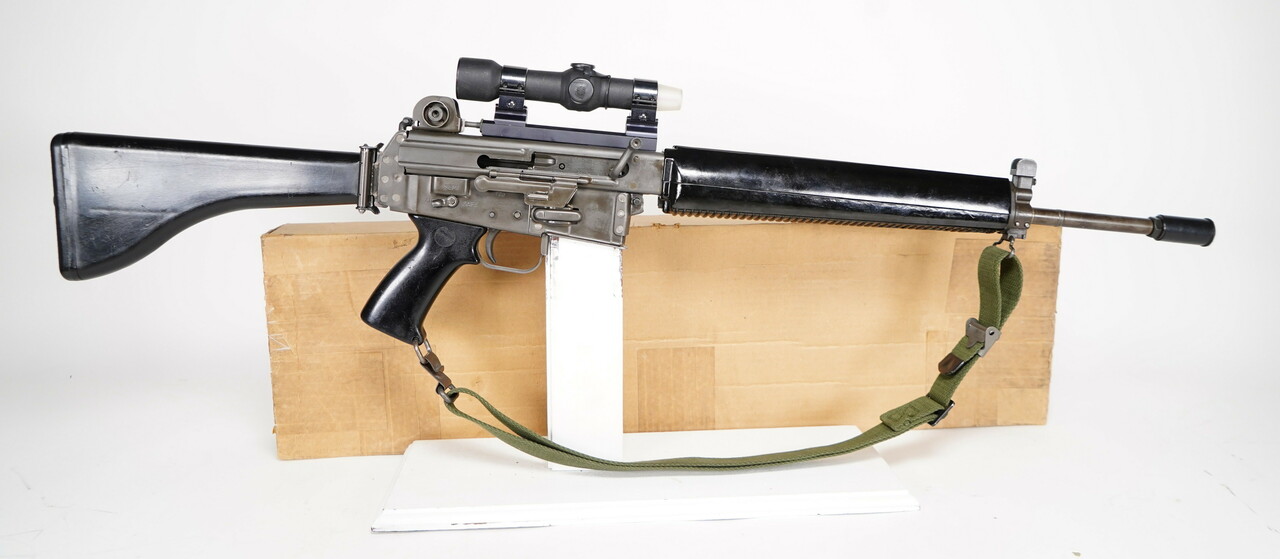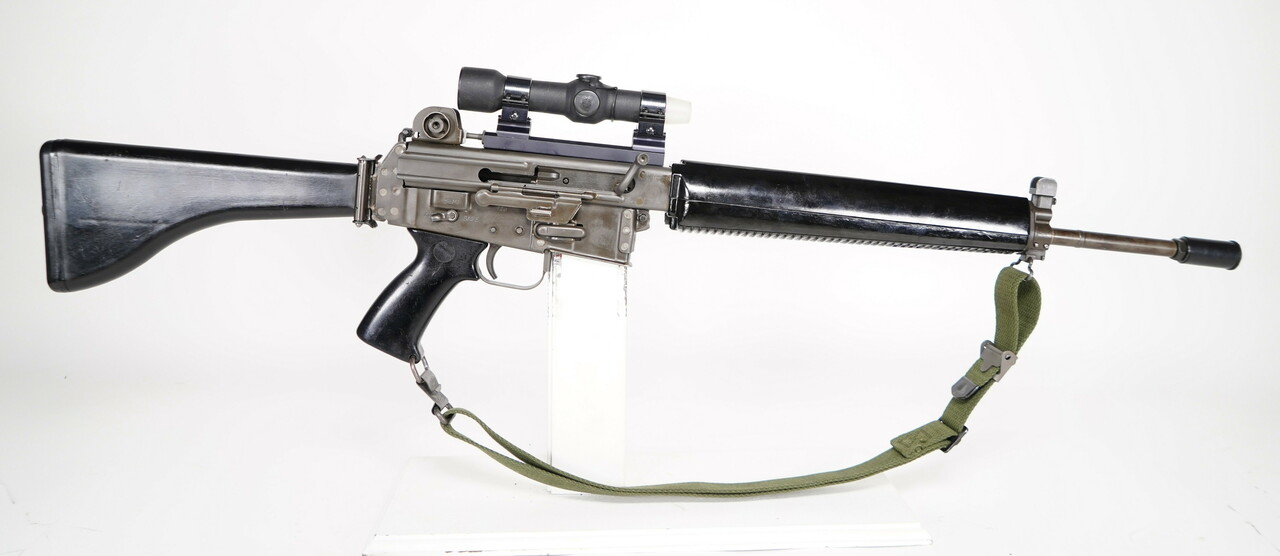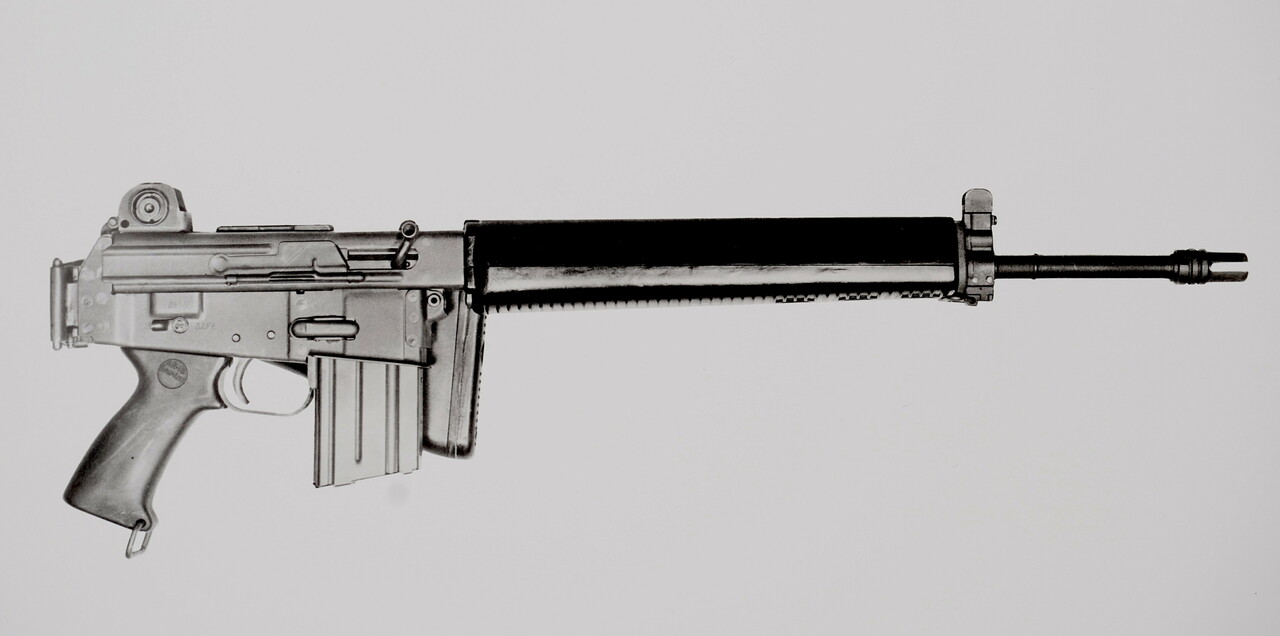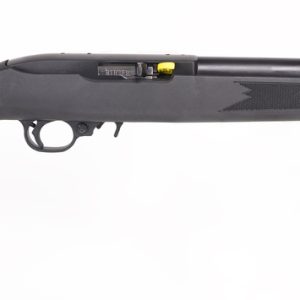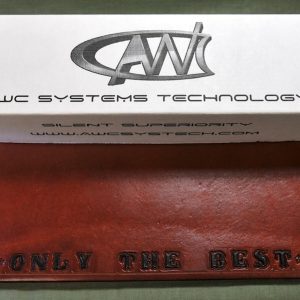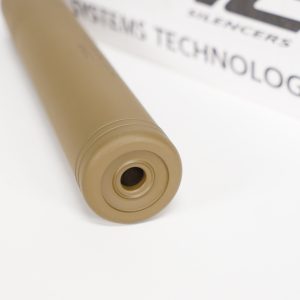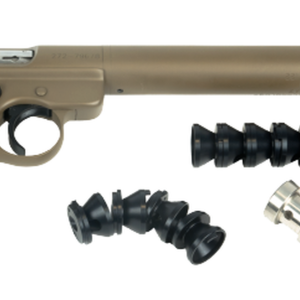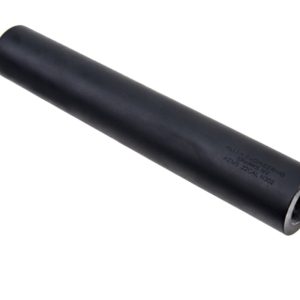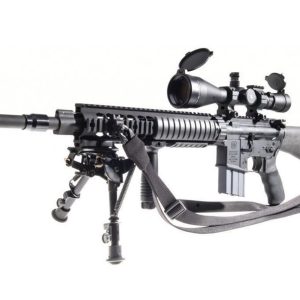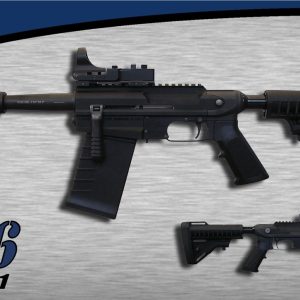


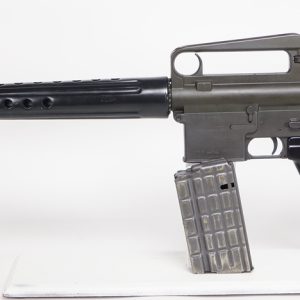
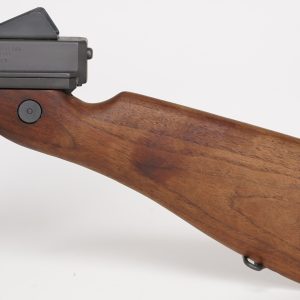
Armalite AR-18 Factory 223 Machine Gun with Box Serial Number 023 !
$24,995.00 Original price was: $24,995.00.$22,495.50Current price is: $22,495.50.
Armalite AR-18
Factory Machine Gun Serial number 023
Background[edit]
This section possibly contains original research. Please improve it by verifying the claims made and adding inline citations. Statements consisting only of original research should be removed. (November 2017) (Learn how and when to remove this template message)
Soon after the adoption of the 7.62×51mm NATO M14 rifle in 1957, the U.S. Army’s Continental Army Command (CONARC) began an investigation of small-caliber, high-velocity (SCHV) rifles as an offshoot of the military’s existing research program, Project SALVO. ArmaLite and Winchester Arms were solicited by CONARC to provide prototype automatic rifles chambered for high-velocity centerfire .22 rounds. The ArmaLite AR-15 was a scaled-down version of the 7.62mm AR-10, which had appeared too late to be a serious contender against the M14 for adoption by the US Army. Its competitor was the Winchester .224 Light Rifle,[10] a “Carbine” Williams prototype carbine design in a .22 high velocity round which was similar to, but not interchangeable with, the .223 Remington (5.56×45mm). During the protracted U.S. military trials of the AR-15, ArmaLite’s corporate owners Fairchild essentially gave up on the design, and sold the AR-15 production rights to Colt. Fairchild also spun off ArmaLite as an independent company, allowing the new owners to buy all of the company’s designs except for the AR-10 and AR-15. When the U.S. military ultimately selected the AR-15 as the M16, ArmaLite could no longer profit from its adoption.
The Armalite AR-16 appeared in the later 1950s. The AR-16, a 7.62mm NATO selective-fire rifle, was Eugene Stoner’s final design for ArmaLite. The AR-16 and its predecessor, the AR-12 were designed by Stoner in response to demands by the military forces of smaller, less developed nations for a less expensive, yet state-of-the-art selective-fire military rifle that unlike the AR-10 and AR-15, could be produced inexpensively of heavy-gauge sheet metal using automatic screw machines, lathes, and presses.[11][12] The AR-12 originally featured a direct-impingement (DI) gas operation system, but this was changed to a more conventional short-stroke gas piston in the AR-16 after ArmaLite sold the production rights to the DI system to Colt Firearms.[11] The AR-16 had a short, 15-inch barrel, hinged wooden butt, and weighed 8.75 pounds empty; only three examples were built.[12] Eugene Stoner left ArmaLite in 1961, shortly before Fairchild divested itself of ownership.[13]
The U.S. military’s later adoption of the AR-15 gave legitimacy to its 5.56mm cartridge, and ArmaLite sought to develop a competing design chambered in 5.56mm that did not infringe on the Colt license agreement. With Stoner gone, it was decided to scale down the AR-16, and ArmaLite’s new chief designer, Arthur Miller, embarked on the project. The resulting 5.56mm design appeared in 1963 and was named the AR-18. Miller later received U.S. Patent 3,246,567 for the rifle in 1969.
Construction and design[edit]
Overall, the new AR-18 rifle is much more conventional than previous ArmaLite designs, although it uses the relatively new stamped steel construction from its predecessor, the AR-16. Despite being pioneered by the Germans during WW2 in weapons such as the MP44, and later adopted for the Soviet AKM, the use of stamped and welded sheet metal components was still uncommon in the manufacture of military rifles in the West in the early 1960s, which had, until then, largely retained the use of traditional machined forgings.[14] Compared to the smooth lines of the AR-15, the AR-18 faced criticism over its stamped and welded construction, which had demonstrably greater tolerances in parts fit.[15][16] However, the rifle proved to be both reliable and very accurate at all ranges up to 460 metres (500 yards). Its simple construction promised significantly reduced production costs, and allowed it to be license-produced locally on less advanced machinery, potentially reducing dependence on foreign manufacturers.[14] Moreover, the gas piston operation of the AR-18 proved much more resistant to carbon fouling than the direct gas impingement system of the earlier AR-10 and AR-15 rifles, as it does not vent gas and carbon particles directly into the receiver.[17]
Short-stroke gas piston
The AR-18’s action is powered by a short-stroke gas piston above the barrel. The gas piston is of three-piece design to facilitate disassembly, with a hollow forward section with four radial gas vent holes fitting around a stainless steel gas block projecting rearwards from the foresight housing. The gas is vented from the barrel and travelled via a vent through the foresight housing into the hollow front section of the piston, which causes it to move rearwards a short distance. The rear end of the piston emerges through the barrel extension to contact the forward face of the bolt carrier, causing it in turn to move rearwards. The bolt itself is of similar configuration to the AR-15 with seven radial locking lugs engaging corresponding recesses in the barrel extension, and the extractor in place of the eighth lug.[18] The bolt is moved into and out of the locked position via a cam pin that engaged a helical slot in the bolt carrier, which rides on two metal guide rods (each with its own return spring) instead of contacting the receiver walls, providing additional clearance for foreign matter entering the receiver.[19] Unlike the AR-15, the cocking handle fits directly into a recess in the bolt carrier and reciprocates with it during firing, allowing the firer to force the breech closed or open if necessary. The cocking handle slot has a spring-loaded cover that can be closed by the user to prevent debris entering the receiver, and it will open automatically as the bolt carrier moves rearwards after the first shot. The recoil springs are housed within the receiver, differing from the AR-15 which houses its more elaborate buffer mechanism in the buttstock. The AR-18’s compact design enables the use of a side-folding stock with a hinging mechanism (which proved to be less than adequately rigid).[16]
The sights are of similar design and sight picture to those of the AR-15 – a 2-position flip aperture rear sight and post foresight – but the rear sight is made of stampings. A notable change is the use of a more conventional lower sight line closer to the axis of the bore, in contrast to the elevated sights of the AR-15. A dovetail is spot welded to the receiver in front of the rear sight for a proprietary ArmaLite quick-detachable scope mount.
The magazines were of a brand new proprietary design and were different than those of the AR-15. The original magazines made by ArmaLite and Howa were of gray-anodized aluminum alloy with black-plastic followers and came in 5- and 20-round capacities. (The 5-round magazine, like that of the Colt AR-15 Sporter, was just a full-size 20-round magazine blocked to only hold 5 rounds.) They lacked the magazine-catch cutouts of the AR-15 magazines, making them incompatible. Sterling later produced black-enameled steel magazines in 20- 30- and 40-round capacities that did have cutouts and were able to feed from an AR-15. However, the AR-18/AR-180 was never capable of using the Colt AR-15/M16’s stock 20- or 30-round STANAG magazines. Gunsmiths have been able to convert AR-15/M16 magazines to feed in the AR-18, but they have to have modified followers or it will put strain on the bolt catch.
The AR-18 was also designed to use the same standard accessories as the M16. It used a three-pronged flash-hider that was similar to that used on the early M16. This was usually replaced by an aftermarket enclosed M16A1 “birdcage”-type model. It could mount the standard M-7 bayonet, although it was not available for sale through ArmaLite. “Sporterized” late-production Howa-made AR-180 rifles had extended metal tabs through the mounting lugs to prevent this. A plastic copy of the fixed folding metal bipod issued with the early M-16 was available and came in a similar protective case. AR-180 users were leery of buying a non-adjustable bipod made of thermoset plastic so few were sold, making it a rare accessory today. A padded rifle case that could carry the rifle with the scope mounted was available. It could hold two spare 20-round magazines and the bipod or bayonet in pouches.
Overall, the design is simple and effective with some clever touches; for example the bolt guide rod assembly guides the bolt in the receiver, retains the recoil springs and the rear end of the top handguard, as well as serving as the latch holding the upper and lower receivers together in the closed position. Disassembly is somewhat similar to the AR-15, with the working parts accessed by the rifle pivoting open on a hinge pin immediately forward of the magazine well.
Production[edit]
A Sterling Armaments AR-180 on display at the National Firearms Museum
The AR-18 was put into limited production at ArmaLite’s machine shop and offices in Costa Mesa, California. A semi-automatic version of the AR-18 known as the AR-180 was later produced for the civilian market between 1969 and 1972. ArmaLite was never equipped to build small arms on a production basis, and the Costa Mesa AR-18 and AR-180 rifles frequently show evidence of hand-fitting. A production license was granted to Nederlandsche Wapen-en Munitiefabriek (NWM) of Den Bosch, the Netherlands, but it is doubtful that any AR-18 rifles were actually produced there.[14] A license to produce the AR-18/180 was then sold to Howa Machinery Co., of Japan, and the rifle was produced from 1970 until 1974, when new controls on export of military arms by the Japanese government forced the company to cease all small arms production.[14] Between 1975 and 1978, there was a brief pause in production as ArmaLite was finalizing an agreement with Sterling Armaments Company to produce the rifle under license. From 1979 until 1985, the Sterling Armaments Company of Dagenham, Essex, in the United Kingdom produced the AR-18 and AR-180.[12][14]In 1983, ArmaLite was sold to Elisco Tool & Manufacturing of the Philippines, who planned to pitch the AR-18 as a replacement for the license-produced M16A1 then in service with the Armed Forces of the Philippines. As a result, production stopped in 1985 as the tooling was sent to the Philippines. In mid-1968 ArmaLite set up pilot production in its Costa Mesa plant producing 1,171 AR-18s and 4,018 AR-180s between 1969 and 1972. Howa produced 3,927 AR-180s between 1970 and 1974.[citation needed] Sterling manufactured 12,362 AR-180s between 1979 and 1985. In all, just 21,478 AR-180s were manufactured over 16 years of production between 1969 and 1985.
Operational use[edit]
Unlike the AR-15/M16, the AR-18 did not see substantial sales success, and was never officially adopted by any country as their standard service rifle. The reasons for this are unclear, but may have had something to do with the existing sales popularity of the AR-15/M16, as well as the need for additional field testing and evaluation of the Costa Mesa-produced rifles, which were still in the advanced prototype stage. The AR-18 was purchased for evaluation trials by various armed forces, including the United States (1964) and the United Kingdom (1966).[1] These suffered various malfunctions during evaluation trials by various nations.[12] During the US trials at Aberdeen Proving Ground in 1964, the AR-18’s functioning was found to vary from lot to lot of ammunition.[20] The evaluating board concluded that while the basic design of the AR-18 was sound, it required additional minor revisions and changes to improve safety and reliability before it could be considered for adoption as a service rifle.[20] The British Ministry of Defence (MOD) tested the AR-18 in March 1966, and found the design unsatisfactory in performance during mud and sand trials. ArmaLite made several minor production modifications to the design commencing in 1965, and the U.S. Army was directed to re-evaluate the AR-18 at the end of 1969. Testing was conducted at Aberdeen Proving Grounds, conducted by arsenal employees and the Infantry Board at Fort Benning, Georgia. However, American procurement officials were not interested in acquiring yet another 5.56 mm service rifle.[12] A number of deficiencies were listed and the testing authority stated that, although the AR-18 had military potential, it needed further development.[21] In 1968, dissatisfied with efforts to market the AR-18, Arthur Miller left ArmaLite.
Instead, the AR-180 was sold on the civilian market, while the AR-18 sold in small quantities to police and law enforcement organizations, as well as armies and security forces of nations such as Botswana, Haiti, Malaysia[22]and Swaziland. Still others found their way into the hands of paramilitary groups, such as the Provisional Irish Republican Army (IRA) in Northern Ireland,[23] (see also Provisional IRA arms importation). The ArmaLite rifle was for many years the most lethal weapon available to the IRA. For this reason, it became an iconic symbol within that movement. The Republican ballad “Little Armalite” tells of how the AR-18 changed the fortunes of the organization in their conflict with Britain.[24] The Armalite company reportedly bought 1000 copies of a recording for its salesmen to distribute.[25][dubious – discuss] The 1980s Republican political strategy of parallel political and paramilitary campaigns was also christened the “Armalite and ballot box strategy”.[26]

